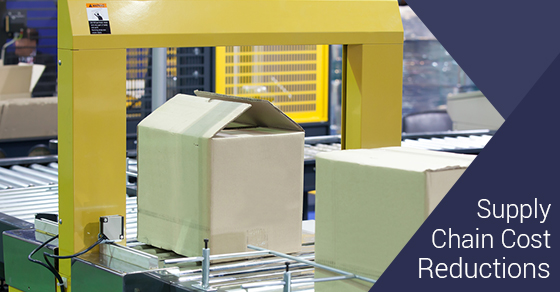One of the best ways to improve your corporate bottom line is to get supply chain costs under control, and fortunately there are some pretty straightforward things you can do to achieve this objective.


Before you get into a cost-cutting frame of mind, however, you need to understand where to focus because making the right cuts in the right areas will ultimately lead to the greatest returns.
What follows is a rundown of the 10 best ways to reduce supply chain costs — and to increase your profits.
- Make Better Use of SpaceMaking the most of the space you have will save you money at the end of the day. As you no doubt already know, storing inventory and supplies in your warehouse comes at a cost. Assess whether or not you’re making the most of the space you have. You just might discover that you could save some money by finding a space that’s more in line with your actual needs.
- AutomateAutomating processes in your warehouse isn’t part of some fad or shady trend. It can actually help you to accomplish your goal of reducing supply chain costs. Have a professional come in to do an assessment of your operations so that you can get suggestions as to how you can automate your operations to make things more efficient.
- Streamline Ordering ProcessYou need to make your ordering process as efficient as possible. This means at least a couple of things. Use a single software package for completing requisitions or else you might encounter situations where employees using different applications end up ordering too much of specific products or inventory supplies. Another thing to keep in mind is that you need to implement an approval process so that nothing gets ordered without the consent of designated officials.
- Monitor Customer DemandOne of the ways you can reduce supply chain costs is by regularly looking at client demand patterns to see whether or not something needs to be tweaked. You may find that patterns change from month to month or from season to season, and you can use this information to make more accurate supply ordering decisions.
- Package WellThe better you package your products, the less likely your products will be damaged when shipped. Ensure that whoever is responsible for this function properly packages and stacks your product so as to avoid, or at least minimize the chances of, damage.
- Consider the LinksAssess all links in your supply chain. In order to get a firm grasp of what you need to overhaul or to tweak, you must come up with answers for questions such as the following:
- What can possibly be eliminated?
- What can possibly be improved?
- What can possibly be changed to enhance overall efficiency?
- JIT Inventory ManagementConsider the benefits of implementing a JIT (Just In Time) inventory management system so that you can order and receive inventory on an as needed basis. This will reduce your inventory carrying fees, safeguard against write-downs attributable to dips in demand and get rid of overhead stemming from excess inventory.
- OutsourcingOutsourcing is one option you can consider if you want to reduce supply chain costs. Of course, you’ll need to conduct proper due diligence to ascertain whether or not service providers under consideration have the ability to provide enough of a productivity and efficiency benefit to justify your out-of-pocket expenses for such services. Under the right set of circumstances, an outsourcing arrangement can lead to substantial savings and a property functioning supply chain.
- Measure PerformanceEven the best strategy will fall flat if you don’t have a way to measure performance. Put another way, you’ll have a hard time determining how much, if any, money you’re saving if you don’t have a sense of how much money you’re spending in the first place. Select critical performance indicators and gauge how you’re doing compared to your goals.
- House in OrderYou must ensure that your in-house operations are working properly and that there are no problems internally that could adversely impact your supply chain. So be sure to carefully assess your internal operations in order to determine whether or not changes need to be made to optimize the performance and efficiency of your supply chain.
It is definitely possible to reduce supply chain costs, and the 10 suggestions above will get you started down that path. You could very well be a few tweaks away from running an efficient supply chain, and you owe it to yourself to critically and objectively assess your situation to determine what, if any, changes need to be implemented.



